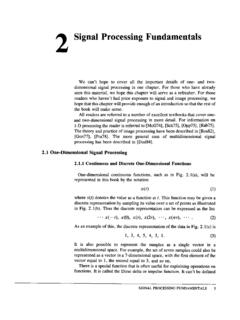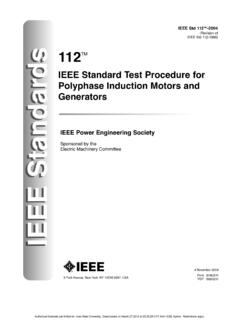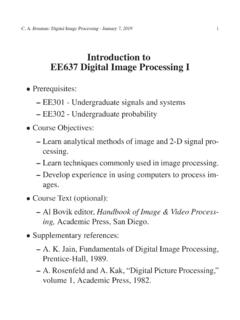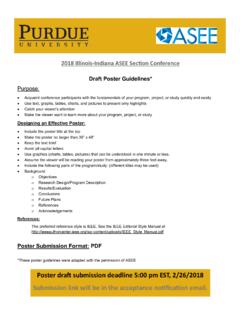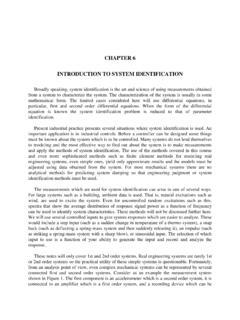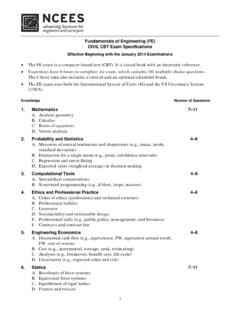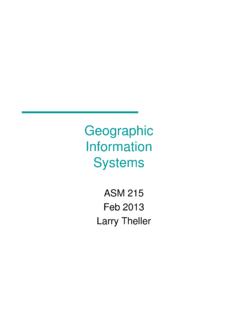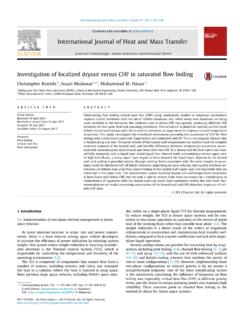Transcription of 3D Modeling of Real-World Objects Using Range and ...
1 This paper appears in: Innovations in Machine Intelligence and Robot Perception Edited by: S. Patnaik, Jain, G. Tzafestas and V. Bannore, Springer-Verlag 3D Modeling of Real-World Objects Using Range and Intensity Images Johnny Park and Guilherme N. DeSouza February 5, 2004. Abstract This chapter describes the state-of-the-art techniques for constructing photo-realistic three dimensional mod- els of physical Objects Using Range and intensity images. In general, construction of such models entails four steps: First, a Range sensor must be used to acquire the geometric shape of the exterior of the object . Objects of complex shape may require a large number of Range images viewed from different directions so that all of the surface detail is captured. The second step in the construction is the registration of the multiple Range images, each recorded in its own coordinate frame, into a common coordinate system called the world frame.
2 The third step removes the redundancies of overlapping surfaces by integrating the registered Range images into a single connected surface model. In order to provide a photo-realistic visualization, the final step acquires the reflectance property of the object surface, and adds the information to the geometric model. 1 Introduction In the last few decades, constructing accurate three-dimensional models of Real-World Objects has drawn much attention from many industrial and research groups. Earlier, the 3D models were used primarily in robotics and computer vision applications such as bin picking and object recognition. The models for such applications only require salient geometric features of the Objects so that the Objects can be recognized and the pose determined. Therefore, it is unnecessary in these applications for the models to faithfully capture every detail on the object surface.
3 More recently, however, there has been considerable interest in the construction of 3D models for appli- cations where the focus is more on visualization of the object by humans. This interest is fueled by the recent technological advances in Range sensors, and the rapid increase of computing power that now enables a computer to represent an object surface by millions of polygons which allows such representations to be visualized interac- tively in real -time. Obviously, to take advantage of these technological advances, the 3D models constructed must capture to the maximum extent possible of the shape and surface-texture information of Real-World Objects . By Real-World Objects , we mean Objects that may present self-occlusion with respect to the sensory devices; Objects with shiny surfaces that may create mirror-like (specular) effects; Objects that may absorb light and therefore not be completely perceived by the vision system; and other types of optically uncooperative Objects .
4 Construction of such photo-realistic 3D models of Real-World Objects is the main focus of this chapter. In general, the construction of such 3D models entails four main steps: 1. Acquisition of geometric data: First, a Range sensor must be used to acquire the geometric shape of the exterior of the object . Objects of complex shape may require a large number of Range images viewed from different directions so that all of the surface detail is captured, although it is very difficult to capture the entire surface if the object contains significant protrusions. 1. 2 ACQUISITION OF GEOMETRIC DATA. 2. Registration: The second step in the construction is the registration of the multiple Range images. Since each view of the object that is acquired is recorded in its own coordinate frame, we must register the multiple Range images into a common coordinate system called the world frame.
5 3. Integration: The registered Range images taken from adjacent viewpoints will typically contain overlapping surfaces with common features in the areas of overlap. This third step consists of integrating the registered Range images into a single connected surface model; this process first takes advantage of the overlapping portions to determine how the different Range images fit together and then eliminates the redundancies in the overlap areas. 4. Acquisition of reflection data: In order to provide a photo-realistic visualization, the final step acquires the reflectance properties of the object surface, and this information is added to the geometric model. Each of these steps will be described in separate sections of this chapter. 2 Acquisition of Geometric Data The first step in 3D object Modeling is to acquire the geometric shape of the exterior of the object .
6 Since acquiring geometric data of an object is a very common problem in computer vision, various techniques have been developed over the years for different applications. Techniques of Acquiring 3D Data The techniques described in this section are not intended to be exhaustive; we will mention briefly only the prominent approaches. In general, methods of acquiring 3D data can be divided into passive sensing methods and active sensing methods. Passive Sensing Methods The passive sensing methods extract 3D positions of object points by Using images with ambient light source. Two of the well-known passive sensing methods are Shape-From-Shading (SFS) and stereo vision. The Shape-From- Shading method uses a single image of an object . The main idea of this method derives from the fact that one of the cues the human visual system uses to infer the shape of a 3D object is its shading information.
7 Using the variation in brightness of an object , the SFS method recovers the 3D shape of an object . There are three major drawbacks of this method: First, the shadow areas of an object cannot be recovered reliably since they do not provide enough intensity information. Second, the method assumes that the entire surface of an object has uniform reflectance property, thus the method cannot be applied to general Objects . Third, the method is very sensitive to noise since the computation of surface gradients is involved. The stereo vision method uses two or more images of an object from different viewpoints. Given the image coordinates of the same object point in two or more images, the stereo vision method extracts the 3D coordinate of that object point. A fundamental limitation of this method is the fact that finding the correspondence between images is extremely difficult.
8 The passive sensing methods require very simple hardware, but usually these methods do not generate dense and accurate 3D data compare to the active sensing methods. 2. 2 ACQUISITION OF GEOMETRIC DATA Structured-Light Scanner Active Sensing Methods The active sensing methods can be divided into two categories: contact and non-contact methods. Coordinate Measuring Machine (CMM) is a prime example of the contact methods. CMMs consist of probe sensors which provide 3D measurements by touching the surface of an object . Although CMMs generate very accurate and fine measurements, they are very expensive and slow. Also, the types of Objects that can be used by CMMs are limited since physical contact is required. The non-contact methods project their own energy source to an object , then observe either the transmitted or the reflected energy. The computed tomography (CT), also known as the computed axial tomography (CAT), is one of the techniques that records the transmitted energy.
9 It uses X-ray beams at various angles to create cross- sectional images of an object . Since the computed tomography provides the internal structure of an object , the method is widely used in medical applications. The active stereo uses the same idea of the passive sensing stereo method, but a light pattern is projected onto an object to solve the difficulty of finding corresponding points between two (or more) camera images. The laser radar system, also known as LADAR, LIDAR, or optical radar, uses the information of emitted and received laser beam to compute the depth. There are mainly two methods that are widely used: (1) Using amplitude modulated continuous wave (AM-CW) laser, and (2) Using laser pulses. The first method emits AM-CW laser onto a scene, and receives the laser that was reflected by a point in the scene. The system computes the phase difference between the emitted and the received laser beam.
10 Then, the depth of the point can be computed since the phase difference is directly proportional to depth. The second method emits a laser pulse, and computes the interval between the emitted and the received time of the pulse. The time interval, well known as time-of-flight, is then used to compute the depth given by t = 2z/c where t is time-of-flight, z is depth, and c is speed of light. The laser radar systems are well suited for applications requiring medium- Range sensing from 10 to 200 meters. The structured-light methods project a light pattern onto a scene, then use a camera to observe how the pattern is illuminated on the object surface. Broadly speaking, the structured-light methods can be divided into scanning and non-scanning methods. The scanning methods consist of a moving stage and a laser plane, so either the laser plane scans the object or the object moves through the laser plane.
